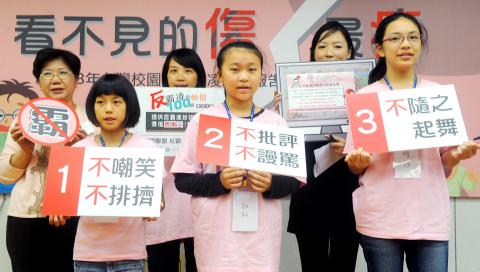The incidence of bullying at schools has significantly dropped from last year, the Children’s Welfare League Foundation said yesterday, adding that a large majority of victims suffer not only physical bullying, but also “relational aggression,” a type of bullying that is easily overlooked and hard to detect, but can result in lasting psychological trauma.
Bullying in schools has decreased since 2007 due to government efforts and rising public awareness, the foundation said.
However, anti-bullying initiatives still face several challenges, it said.

Photo: Wang Min-wei, Taipei Times
Teachers and parents often overlook relational aggression, with victims choosing to remain silent as they believe that speaking out about bullying will not help.
According to a survey conducted earlier this year, 16.3 percent of fourth, fifth and sixth graders were said to have experienced bullying at school.
Of those, 94.8 percent were victims of relational bully.
Children’s Welfare League Foundation research and development director Chiu Ching-hui (邱靖惠) said that relational bullying often involves the intentional social exclusion of a victim or spreading rumors to ruin the victim’s social networks, and can cause the victims to feel detached and depressed.
“However, according to another survey conducted online, 93.7 percent of parents and 88.7 percent of children polled take school bullying to be physical violence only, while 30 percent of them think that boys are more likely to become bullies. What’s more, 26 percent of children do not consider peer exclusion as a kind of school bullying,” Chiu said.
Relational bullying has also been aggravated by the Internet.
The survey shows that 62.4 percent of children consider cyberbullying more serious than real-life bullying, reflecting the fact that it is easier to victimize children in a world where real-life rules and adult oversight are lacking.
Many victims do not reveal the bullying to adults, for fear of revenge or being slighted as a “whistle-blower” or because they fear adults’ countermeasures.
Children’s distrust is actually disappointingly justified, the foundation said, as the survey found that 78 percent of reported cases were not resolved properly or even deteriorated.
As worrying as children’s distrust is parents’ distrust of teachers, Chiu said.
“Nearly half of the parents felt all channels of help were closed to them when they needed one, and more than half of them do not believe teachers can be trusted in solving the issue if their kids are bullied,” Chiu said.
While more government attention and action are necessary, the children’s foundation is also asking for children’s assistance in eradicating school bullying, encouraging them not to ridicule, exclude, slander or reinforce bullying, but to respect fellow students and take action against bullying.
Bullying is a group phenomenon, Chiu said, adding that “both the individuals involved in a bullying case and the class as a whole have to be educated.”

US climber Alex Honnold is to attempt to scale Taipei 101 without a rope and harness in a live Netflix special on Jan. 24, the streaming platform announced on Wednesday. Accounting for the time difference, the two-hour broadcast of Honnold’s climb, called Skyscraper Live, is to air on Jan. 23 in the US, Netflix said in a statement. Honnold, 40, was the first person ever to free solo climb the 900m El Capitan rock formation in Yosemite National Park — a feat that was recorded and later made into the 2018 documentary film Free Solo. Netflix previewed Skyscraper Live in October, after videos

Starting on Jan. 1, YouBike riders must have insurance to use the service, and a six-month trial of NT$5 coupons under certain conditions would be implemented to balance bike shortages, a joint statement from transportation departments across Taipei, New Taipei City and Taoyuan announced yesterday. The rental bike system operator said that coupons would be offered to riders to rent bikes from full stations, for riders who take out an electric-assisted bike from a full station, and for riders who return a bike to an empty station. All riders with YouBike accounts are automatically eligible for the program, and each membership account

A classified Pentagon-produced, multiyear assessment — the Overmatch brief — highlighted unreported Chinese capabilities to destroy US military assets and identified US supply chain choke points, painting a disturbing picture of waning US military might, a New York Times editorial published on Monday said. US Secretary of Defense Pete Hegseth’s comments in November last year that “we lose every time” in Pentagon-conducted war games pitting the US against China further highlighted the uncertainty about the US’ capability to intervene in the event of a Chinese invasion of Taiwan. “It shows the Pentagon’s overreliance on expensive, vulnerable weapons as adversaries field cheap, technologically

Temperatures are forecast to drop steadily as a continental cold air mass moves across Taiwan, with some areas also likely to see heavy rainfall, the Central Weather Administration (CWA) said. From today through early tomorrow, a cold air mass would keep temperatures low across central and northern Taiwan, and the eastern half of Taiwan proper, with isolated brief showers forecast along Keelung’s north coast, Taipei and New Taipei City’s mountainous areas and eastern Taiwan, it said. Lows of 11°C to 15°C are forecast in central and northern Taiwan, Yilan County, and the outlying Kinmen and Lienchiang (Matsu) counties, and 14°C to 17°C